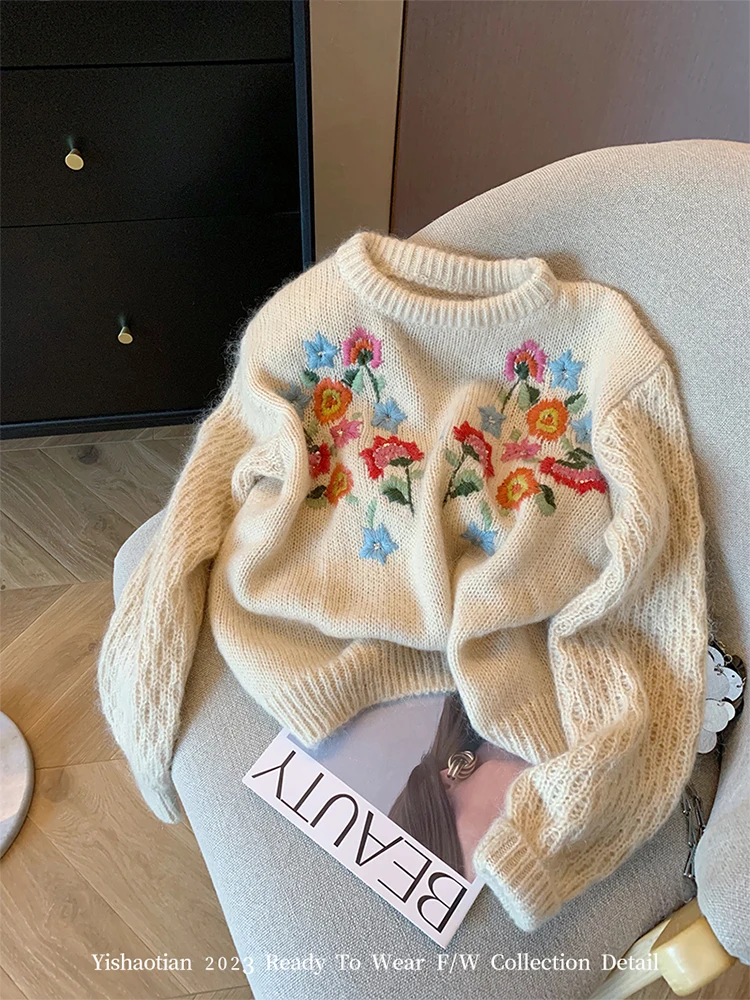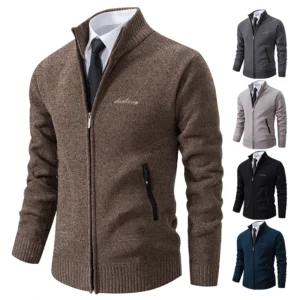Introduction to Luxury Cashmere: Understanding the Scottish and Mongolian Difference
Cashmere stands as one of the world’s most coveted luxury fibers, prized for its exceptional softness, remarkable warmth-to-weight ratio, and unmatched comfort against the skin. This natural miracle fiber—measuring just 14-19 microns in diameter compared to regular wool’s 24-40 microns—comes from the soft undercoat of the Capra hircus goat, an animal specially adapted to survive in some of the world’s harshest climates.
While cashmere is produced in several regions worldwide, Scottish and Mongolian varieties represent two distinct approaches to cashmere excellence, each with loyal advocates in the luxury market. These two origins have developed different yet equally respected traditions in creating premium cashmere garments.
Throughout this article, we’ll compare these prestigious varieties using specific quality criteria: fiber diameter (microns), length, processing methods, and finishing techniques. Understanding these factors provides insight beyond simple country-of-origin labels. The differences in styling tips for cashmere cardigans often stem from these fundamental quality variations between Scottish and Mongolian fibers.
What Defines Premium Cashmere Quality: Essential Metrics
To properly evaluate Scottish and Mongolian cashmere, it’s important to understand the key factors that determine exceptional quality:
Fiber diameter (microns): The thickness of individual fibers directly impacts softness. Premium cashmere typically measures 14-16 microns, while average quality ranges from 16-19 microns. The finer the fiber, the softer the feel against skin.
Fiber length: Longer fibers (exceeding 36mm or 1.4 inches) create stronger yarns with significantly better durability and pilling resistance compared to shorter fibers (28-32mm or 1.1-1.3 inches).
Ply construction: The number of yarn strands twisted together affects durability and warmth. Single-ply constructions offer lightness but less durability, while two-ply and multi-ply constructions provide superior strength and longevity.
Gauge measurements: This refers to the knitting density, with finer gauges creating lighter fabrics and heavier gauges producing warmer, more substantial pieces.
Processing quality: The careful sorting, deharing (removing coarse guard hairs), spinning, and finishing dramatically impact the final product’s quality regardless of origin.
Dye absorption: Superior cashmere accepts dyes evenly and maintains color integrity over time.
When considering whether cashmere cardigans are worth the investment, these quality metrics become crucial evaluation points. The differences between brushed vs. classic cashmere also stem from variations in these fundamental characteristics and processing techniques.
Mongolian Cashmere: The Origin of Exceptional Raw Fiber
Geographic and Climatic Influence
Mongolia’s harsh climate creates the perfect environment for producing exceptional cashmere fibers. The Gobi region experiences extreme temperature fluctuations ranging from -40°F to 95°F (-40°C to 35°C), forcing goats to develop incredibly fine, dense undercoats for survival. This natural adaptation directly translates to superior insulation properties in the finished garments.
The high altitudes and sparse vegetation of Mongolia’s plateaus further contribute to the unique qualities of the fiber. Goats must forage widely for nutrition, which affects the protein structure of their coats and ultimately enhances fiber strength.
Mongolian Goat Breeds and Harvesting
Mongolian cashmere comes primarily from indigenous goat breeds that have adapted over centuries to the region’s harsh conditions. These animals grow exceptionally fine undercoats during winter months, which are then naturally shed as temperatures rise in spring.
Traditional harvesting involves hand-combing rather than shearing, allowing herders to collect only the fine undercoat while leaving coarser guard hairs behind. This labor-intensive process typically occurs once annually during spring, yielding approximately 4-6 ounces (100-150 grams) of precious undercoat per goat.
Inner Mongolian Premium Quality
Inner Mongolian cashmere is particularly prized for its exceptional quality. The region’s harsher winters and unique vegetation result in fibers that typically measure:
– 14-16 microns in diameter (extremely fine)
– 38-42mm (1.5-1.65 inches) in length
– Exceptional tensile strength despite fineness
These characteristics make Inner Mongolian cashmere especially resistant to pilling while maintaining extraordinary softness. Our cashmere sweater collection incorporates these quality fibers to deliver both comfort and longevity.
Scottish Cashmere: Mastery in Processing and Finishing

Historical Development
Scotland’s relationship with cashmere began as an extension of its centuries-old wool industry. Traditional textile centers like Hawick and Elgin gradually adapted their wool expertise to work with the finer cashmere fibers, developing specialized techniques that would come to define Scottish cashmere’s distinctive character.
This evolution created a manufacturing tradition focused less on raw material production (Scotland doesn’t raise cashmere goats) and more on the transformation of raw fiber into exceptional finished products.
The Distinctive Scottish Approach
What truly distinguishes Scottish cashmere is its unparalleled processing methodology:
Water quality: Scottish manufacturing regions benefit from soft water with unique mineral compositions that enhance fiber cleaning and contribute to the characteristic soft handle of Scottish cashmere.
Traditional milling: Time-tested techniques like “fulling” (controlled friction application) create fabric density without excessive weight.
Color expertise: Scottish mills have developed renowned color development processes, producing rich, nuanced hues with exceptional colorfastness.
“Made in Scotland” Quality Standards
Scottish cashmere adheres to strict quality parameters:
– Minimum fiber length of 34mm (1.34 inches)
– Maximum thickness of 16.5 microns
– Rigorous testing for pilling resistance, tensile strength, and color stability
– Multi-stage inspection throughout the manufacturing process
Distinctive Characteristics
Scottish cashmere is typically characterized by:
– Exceptional durability and shape retention
– A slightly more substantial hand-feel than some Asian-produced varieties
– Superior construction with particular attention to seams and finishing details
– Remarkable longevity with proper care
Our cashmere cardigan selection exemplifies these Scottish finishing techniques that create garments designed to last for years.
Direct Comparison: Scottish vs. Mongolian Cashmere Characteristics
When directly comparing Scottish and Mongolian cashmere, several important distinctions emerge across key quality dimensions:
Softness and Handle
Mongolian Cashmere:
– Often exhibits superior initial softness due to extremely fine fibers (typically 14-15 microns)
– Creates lightweight fabrics with exceptional drape
– May become even softer with proper washing over time
Scottish Cashmere:
– Features a distinctive “dry” hand that many connoisseurs prefer
– Often has slightly more substantial weight and structure
– Maintains its tactile quality consistently through many wears and washes
Durability Factors
Mongolian Cashmere:
– Excels in natural fiber length (38-40mm), enhancing resistance to pilling
– Inner Mongolian varieties particularly known for longevity
– May require more careful handling to maintain structure
Scottish Cashmere:
– Renowned for exceptional construction techniques that enhance durability
– Superior pilling resistance due to processing methods rather than just raw fiber quality
– Excellent shape retention through multiple seasons of wear
– Often maintains structural integrity longer through repeated wearing
Thermal Properties
Mongolian Cashmere:
– Superior insulation-to-weight ratio due to extremely fine fibers
– Excellent for lightweight yet warm garments
– Natural crimp of fibers creates more air pockets for insulation
Scottish Cashmere:
– Often constructed at slightly heavier gauges for enhanced warmth
– Creates a more substantial barrier against cold and wind
– Balanced breathability prevents overheating
Aesthetic Qualities
Mongolian Cashmere:
– Often exhibits a subtle natural luster
– Takes dye beautifully with a characteristic luminous quality
– Typically offers exceptional drape and movement
Scottish Cashmere:
– Distinguished by rich, complex color development
– Often features a more matte, sophisticated finish
– Superior structure creates clean lines in tailored styles
For more detailed analysis on this comparison, our guide to Mongolian vs. Scottish cashmere explores these differences further. Understanding these quality factors can also enhance your knowledge when layering cashmere cardigans for different seasonal needs.
Factors Beyond Origin: What Truly Determines Cashmere Quality
While geographic origin significantly influences cashmere quality, several other critical factors determine the excellence of the final product:
Raw Material Selection and Grading
– Grade A (under 16.5 microns): Finest, softest fibers used in premium garments
– Grade B (16.5-19 microns): Good quality but slightly less soft
– Grade C (over 19 microns): Lower quality with less softness and more potential for pilling
– The practice of blending different grades significantly impacts final qualityManufacturing Processes
– Spinning techniques determine yarn evenness and strength
– Knitting tension affects fabric performance and durability
– Modern technology combined with traditional knowledge creates superior productsFinishing Treatments
– Mechanical finishing (brushing, pressing) vs. chemical treatments
– Softener applications can enhance initial feel but may compromise long-term performance
– Water quality in washing processes affects fiber alignment and hand-feelQuality Control Standards
– Testing for pilling resistance, colorfastness, and dimensional stability
– Certifications that verify fiber quality and ethical production
– Consistency checks throughout productionBrand Commitment
– Transparency in sourcing and production methods
– Consistent quality standards across product ranges
– Investment in proper manufacturing rather than cutting corners
Our brushed cashmere sweater collection demonstrates how specialized finishing techniques can enhance specific characteristics of the fiber regardless of origin.
How to Identify High-Quality Cashmere Regardless of Origin

Learning to evaluate cashmere quality empowers you to make informed purchasing decisions regardless of whether you’re considering Scottish, Mongolian, or other origins:
Visual Assessment
- Look for even, tight knitting without irregularities
- Check for a subtle luster rather than a shiny appearance (extreme shine often indicates synthetic fibers or silicone treatments)
- Examine seams and finishing details for precision and care
- Assess color evenness throughout the garment
Tactile Evaluation
- Perform the “cheek test” by gently rubbing the fabric against your cheek—quality cashmere feels soft without scratchiness
- Roll the fabric between your fingers—premium cashmere feels smooth and substantial without being heavy
- Gently stretch the fabric—it should return to shape quickly
- Quality cashmere has a distinctive “dry” hand that feels clean rather than slippery
Label Interpretation
- Look for specific information about ply (2-ply is generally superior to single-ply)
- Check for detailed fiber content (100% cashmere vs. blends)
- Be wary of vague origin claims without specific quality information
- Premium brands will often specify fiber grade or micron count
Price Considerations
- Quality cashmere is never inexpensive due to the scarcity of raw material and labor-intensive processing
- Suspiciously low prices for “100% cashmere” often indicate inferior fiber, blending with synthetic materials, or problematic production methods
- Consider cost-per-wear rather than just initial investment
Our cashmere wool cardigan collection demonstrates how even blended materials can be evaluated using these quality indicators when premium manufacturing standards are maintained.
Choosing Between Scottish and Mongolian Cashmere: Finding Your Perfect Match
Selecting the ideal cashmere for your needs depends on several personal factors:
Intended Use
Best for Everyday Wear:
– Scottish cashmere often offers better durability for daily use
– More structured pieces maintain their shape through frequent wearing
– Better resistance to the friction of regular wear
Best for Luxury and Special Occasions:
– Mongolian cashmere’s exceptional softness creates memorable luxury experiences
– Lighter weight makes it ideal for special garments
– Superior drape for more formal or elegant pieces
Personal Priorities
If You Value Maximum Softness:
– Premium Mongolian cashmere typically offers superior initial softness
– Inner Mongolian varieties particularly excel in this characteristic
If You Value Longevity:
– Scottish processing techniques often create more durable finished products
– Better structure retention over many years of wear
– Potentially better value over the long term
Climate Considerations
For Cold, Damp Climates:
– Scottish cashmere’s slightly more substantial construction offers better protection
– Better performance in windy conditions
– Traditional Scottish designs often feature practical details for challenging weather
For Dry Cold or Layering:
– Mongolian cashmere’s lightweight warmth excels for layering
– Better breathability for transitional seasons
– Superior insulation-to-weight ratio
Our women’s cashmere pullover collection offers options that incorporate the strengths of both traditions to suit different wearing occasions and preferences.
Cashmere Wrap Sweaters, Women's Cashmere Pullovers
$75.89 Select options This product has multiple variants. The options may be chosen on the product pageCashmere Cable Knit Sweaters, Women's Cashmere Pullovers
Price range: $111.82 through $112.93 Select options This product has multiple variants. The options may be chosen on the product pageCropped Cashmere Sweaters, Women's Cashmere Pullovers
$155.77 Select options This product has multiple variants. The options may be chosen on the product page- Price range: $102.02 through $109.37 Select options This product has multiple variants. The options may be chosen on the product page
Oversized Cashmere Sweaters, Plus Size Cashmere Sweaters, Women's V-Neck Cashmere Sweaters
$136.87 Select options This product has multiple variants. The options may be chosen on the product pageStriped Cashmere Sweaters, Women's Cashmere Pullovers
$139.68 Select options This product has multiple variants. The options may be chosen on the product page
The Future of Premium Cashmere: Combining Mongolian Excellence and Scottish Craftsmanship

The most exciting development in luxury cashmere is the growing trend toward combining Mongolian raw material excellence with Scottish manufacturing expertise. This hybrid approach represents the best of both worlds: the incomparable fineness of Mongolian fibers enhanced by Scotland’s unmatched finishing techniques.
Forward-thinking brands like Estate Cloth are embracing this synergy, sourcing the finest raw materials from Mongolia’s historic cashmere regions while applying processing expertise developed in Scotland’s traditional manufacturing centers. The result is truly exceptional cashmere that offers both immediate luxury and long-term value.
Sustainability is becoming increasingly central to premium cashmere production. Ethical sourcing practices that support nomadic herding communities while preserving fragile ecosystems represent the future of responsible luxury. Similarly, Scottish processing innovations are reducing water usage and environmental impact while maintaining quality standards.
As consumer education improves, more buyers understand that true cashmere quality transcends simple country-of-origin labels. When considering options between thick and light cashmere, today’s educated consumers recognize that quality factors from both traditions contribute to creating exceptional garments.
By appreciating the unique contributions of both Mongolian and Scottish cashmere traditions, today’s discerning customers can make more informed choices that align with their specific needs and values.







